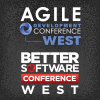Agile Development Conference & Better Software Conference West 2012

PRESENTATIONS
|
How to Rework Poorly Defined Requirements
Poorly defined requirements are even more dangerous than no requirements because they offer the illusion that all is well during development. However, when user acceptance testing begins, requirements problems surface and the users rightly say, “I don’t care that the system test has passed, this isn’t what we need, and we won’t be signing off.” Steve Caseley reviews the actions he took to rework the requirements on two failed projects and the changes he made to get new projects off to the right start. |

Steve Caseley, CBTNuggets |
|
Implementing Agile in an FDA-regulated Environment
While many industries have adopted agile, the medical device industry, which develops products for life-critical applications-where quality and reliability are clearly a top-priority, remains largely stuck under the “waterfall.” Medical device firms must comply with FDA regulations that overwhelmingly suggest a controlled, phase-gated approach to software development. Unfortunately, many companies and development organizations interpret FDA regulations to require a steep waterfall. |
|
|
Implementing Agile in the Cloud with a Large Distributed Team
Jeremy Leach shares Pitney Bowes’ agile development experience implementing a cloud-based application with a large, globally-distributed team. Jeremy’s story recounts challenges working with the very specific delivery cycles required by third-party contractors and hardware vendors. He describes the interactions and complexities that a global engineering team face when multiple project and products must come together into a single release. |
|
|
Influence v. Authority: Using Your Personal Power to Get Things Done
How often have you been in a situation where you could see the solution and yet did not have the authority to make a change? You tried persuasion; you tried selling your ideas; you might have even tried friendly manipulation to get your way. And nothing worked. Here’s a new plan. We can learn to develop and use personal power and influence to effect positive changes in our companies. |

Johanna Rothman, Rothman Consulting Group, Inc. |
|
Integrating Systems Thinking into Enterprise Agile
While Scrum and XP have become very popular in agile development shops, most companies adopting them run into problems beyond just a few teams. These challenges often fall into a common set of patterns, which points to a lack of systems thinking-the process of understanding how things influence one another within a larger whole. Alan Shalloway shares his ideas on how the agile community can move beyond its team-centric approach to adopt a more holistic, systems-based approach. |
|
|
Is Open Source Too Open? Tips for Implementing a Governance Program
By next year, 90 percent of large enterprises will include open-source software as business critical elements of their IT portfolios. However, most software development organizations have limited capability to govern the process of selecting, managing, and distributing open-source components-leaving them exposed to unforeseen technical and compliance risks. Larry Roshfeld examines how open-source components-and their dependencies-may expose your company to unforeseen and unnecessary vulnerabilities. |
|
|
Journey to Agility: Leading the Transformation
How far can you take agile within an organization? Is it enough to just focus on agile development practices such as Scrum and XP or is something more needed? Agile is much more than just a development methodology. Beyond product development, it can become an organizational strategy for increased success. Skip Angel shares an example of one company's journey from no knowledge of agile to an organization of high agility. |
|
|
Lean Product Management: When Phase/Gate Is the Wrong Choice
More than 70 percent of new software products fail or perform below expectations. Achieving product-market fit is essential-and doing it quickly and within budget increases your chances of success. However, the methods you should use depend on the problems you are trying to solve. The predominant phase-gate model used today is not always the right choice or fastest path to market. As an alternative, lean product management approaches focus attention on applying the right process at the project level. |

Greg Cohen, 280 Group |
|
Leaping into the Cloud: Risks and Mitigation Strategies
The cloud has rapidly gone from “that thing I should know something about” to the “centerpiece of our five-year corporate IT strategy.” However, cloud computing is still in its infancy. The marketing materials ignore or gloss over the many risks present today in the cloud-data loss, security leaks, gaps in availability, migration costs, and more. Ken Johnston and Seth Eliot share new research on the successful migrations of corporate IT and web-based companies to the cloud. |
Ken Johnston, Microsoft Corporation |
|
Lessons from a DevOps Journey
In large financial institutions, treasury departments-specialized teams of traders and experts in liquidity, risk, accounting, financial forecasting, and quantitative analysis-manage the organization’s wealth and financial risk. These departments require large, complex, third-party software products that must change often to support the treasury’s complicated business processes. |
|
Pages
Recommended Web Seminars
| On Demand | Building Confidence in Your Automation |
| On Demand | Leveraging Open Source Tools for DevSecOps |
| On Demand | Five Reasons Why Agile Isn't Working |
| On Demand | Building a Stellar Team |
| On Demand | Agile Transformation Best Practices |


